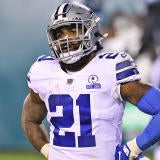
You can't talk about the Steelers' 1970s dynasty without mentioning Mel Blount, a first-ballot Hall of Famer who played an integral role in each of Pittsburgh's four championships from 1974-79. Blount was so dominant he inspired a rule that forever changed the NFL.
When Blount began what turned into a Hall of Fame career over 50 years ago, he was unlike any other cornerback who proceeded him. The prototype for a perfect NFL cornerback, Blount had the size (6-foot-3 and 205 pounds), speed (he ran a low 4.4 in the 40-yard dash) and natural athletic skills to dominate opposing receivers. Blount parlayed his physical skills into a decorated career that in 2019 included his inclusion on the NFL 100 All-Time Team.
In celebration of his 76th birthday (Blount was born on April 10, 1948), here are five fast facts about the Steelers legend.
1. The 'Mel Blount Rule'
Blount and the Steelers had already begun their dynasty prior to the 1978 season after winning back-to-back Super Bowls in 1974-75. But it appeared that the NFL Competition Committee was intent on stopping the Steelers from further league domination entering the '78 season.
That offseason, the Committee, which was led back then by then-Dolphins coach Don Shula, instituted several rules that favored offenses while promoting higher-scoring contests. One of the changes was a rule that prohibited the contact between defensive backs and receivers. From its inception, that rule has been known in history as the "Mel Blount Rule." And while he really didn't like it at first, Blount has grown to enjoy that part of his playing legacy.
"When that happened, to me, I took it as an insult," Blount recalled during a 2021 interview with the All Things Covered Podcast with Patrick Peterson & Bryant McFadden. "As if, 'OK, so you're putting this rule in because you think that's the only way I can play and that it's going to slow me down.' We were so dominant … Joe Greene, L.C. Greenwood, Jack Lambert. We were so dominant. They were trying to find ways to slow our defense down. … I didn't really like the rule, but I wanted to prove that there was another gear that I could go to, another level. So we were able to go win two (more) Super Bowls after they changed that rule."
As Blount alluded to, the new rules did little to slow down the Steelers. Pittsburgh was actually better, as the rules opened things up for Terry Bradshaw and the Steelers' passing attack. Bradshaw won league MVP in 1978 as well as the next two Super Bowl MVP awards. Pittsburgh's defense was first in the league in points allowed in 1978 and fifth in 1979.
2. Defensive Player of the Year
Blount became the second Steelers player to win NFL Defensive Player of the Year in 1975. Joe Greene, Blount's Hall of Fame teammate for 12 of his 14 seasons in Pittsburgh, won the honor in 1972 and 1974. Jack Lambert, the Steelers' Hall of Fame inside linebacker from 1974-84, won the award a year after Blount in 1976.
In 14 games, Blount recorded a league-high 11 interceptions during the 1975 season. Along with winning DPOY, that marked the first season where Blount was named a Pro Bowler as well as an All-Pro. His play that season helped the Steelers go 12-2 during the regular season before successfully defending their title.
“Football is a physical game, well it used to be anyways.
— Old Time Football 🏈 (@Ol_TimeFootball) March 2, 2023
One of the things I wanted to do was let people know this is my territory, you come in here you’re going to have to pay” - Mel Blount #MelBlountRule#Steelers pic.twitter.com/Hsv8UqMHJW
3. Super Bowl success
Blount recorded three interceptions during the Steelers' four Super Bowl wins during the 1970s. Two of those picks came against future Hall of Fame quarterback Roger Staubach in the Steelers' two Super Bowl wins over the Cowboys. Blount's pick against Staubach late in the first half of Super Bowl XIII set up the go-ahead score in Pittsburgh's eventual 35-31 win.
Along with his interception, Blount held Cowboys Hall of Fame wideout Drew Pearson to zero receptions until late in the fourth quarter when the Steelers were already ahead 35-17. The win gave the Steelers a record third Super Bowl win and the unofficial title as the "Team of the Decade."
Between players, coaches & executives, Super Bowl XIII between the @steelers & @dallascowboys featured a record TWENTY SIX future Hall of Famers.
— Pro Football Hall of Fame (@ProFootballHOF) January 21, 2023
In other words, 7% of all Hall of Famers took part in this game #OTD in 1979, where PIT claimed the title with a 35-31 win.
📹: @NFL pic.twitter.com/Finc9QAtJt
4. New decade, same Blount
While Blount is known for his brilliance during the Steelers' dynasty years, he was actually named to the NFL's All-Decade Team in the 1980s instead of the '70s. Blount played in the decade's first four seasons and was an All-Pro in 1981 after picking off six passes. He intercepted four passes in 1983 in what was the final season of his career.
5. The GOAT?
While some consider Deion Sanders to be the best cornerback in NFL history, many others feel Blount owns that title given his versatility and lasting impact on the game.
Happy Birthday to Mel Blount Best CB to ever play in the NFL! @steelers @MelBlountYLI pic.twitter.com/oyG7KdamPg
— Rod Woodson (@RodWoodson26) April 10, 2023
Rod Woodson, who, like Blount is a former Steelers Hall of Fame defensive back with a DPOY in his trophy case, feels Blount is the greatest cornerback who has ever graced a football field.






















